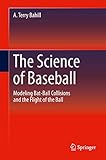The Science of Baseball [electronic resource] : Modeling Bat-Ball Collisions and the Flight of the Ball / by A. Terry Bahill.
By: Bahill, A. Terry [author.] .
.
Contributor(s): SpringerLink (Online service) .
.
Material type:  BookPublisher: Cham : Springer International Publishing : Imprint: Springer, 2018Edition: 1st ed. 2018.Description: XXI, 223 p. 60 illus., 50 illus. in color. online resource.Content type: text Media type: computer Carrier type: online resourceISBN: 9783319670324.Subject(s): Mechanics, Applied
BookPublisher: Cham : Springer International Publishing : Imprint: Springer, 2018Edition: 1st ed. 2018.Description: XXI, 223 p. 60 illus., 50 illus. in color. online resource.Content type: text Media type: computer Carrier type: online resourceISBN: 9783319670324.Subject(s): Mechanics, AppliedTypes of Bat-ball Collisions -- Configurations of Bat-ball Collisions -- Equations for Bat-ball Collisions -- The ConLaw Model for Bat-ball Collisions -- Alternative Models -- The Ball in Flight Model -- Dénouement -- General Modeling Principles.
This book describes the dynamic collisions between baseballs, softballs, and bats, and the intricate modeling of these interactions, using only Newton’s basic principles and the conservation laws of physics. Veteran baseball science author Terry Bahill explains models for the speed and spin of balls and bats and equations for bat-ball collisions at a level accessible to high school and undergraduate physics students, engineering students, and, most importantly, students of the science of baseball. Unlike other, more technical accounts of these phenomena that exhibit similar rigor, the models presented in this volume use only basic physical principles to describe simple collision configurations. Elucidating the most important factors for understanding bat performance—bat weight, moment of inertia, the coefficient of restitution, and characteristics of humans swinging the bats, Dr. Bahill also explains physical aspects of the ideal bat and the sweet spot. • Explains how to select or design an optimal baseball or softball bat and create models for bat-ball collisions using only fundamental principles of mechanics from high school physics; • Describes the results of the collision between baseball and bat using basic mathematics such as equations for the speed of the ball after the collision, bat speed after the collision, and bat rotation after the collision; •Accessible to high school and undergraduate students as well as non-technical aficionados of the science of baseball. “Dr. Bahill’s book is the perfect tool for teaching how to solve some of baseball’s basic science problems. Using only simple Newtonian principles and the conservation laws, Dr. Bahill explains how to model bat-ball collisions. Also, he derives equations governing the flight of the ball, and proceeds to show what factors affect air density and how this density affects the ball’s flight. And as a unique addition to his fine book, he provides advice for selecting the optimal bat—a surprising bonus!” Dave Baldwin, PhD Major League pitcher, 1966-1973, lifetime Major League ERA, 3.08 “If I were the General Manger of a baseball team, I would tell my people to write a ten-page paper describing what this book contains that could improve our performance. I think the book provides the foundation for change.” Bruce Gissing Executive VP-Operations (retired) Boeing Commercial Airplanes “[I] had a chance to read your research, and I fully agree with your findings.” Baseball Legend Ted Williams, in a 1984 letter to the author.


There are no comments for this item.